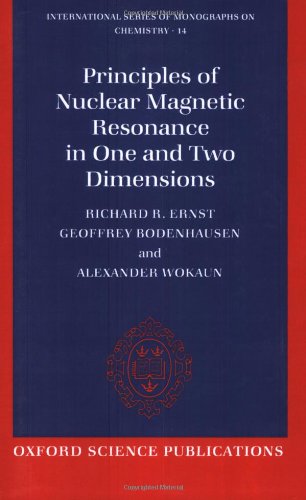Principles of nuclear magnetic resonance in one and two dimensions ebook download
Par bogard adeline le samedi, août 27 2016, 04:37 - Lien permanent
Principles of nuclear magnetic resonance in one and two dimensions by Alexander Wokaun, Geoffrey Bodenhausen, Richard R. Ernst


Download eBook
Principles of nuclear magnetic resonance in one and two dimensions Alexander Wokaun, Geoffrey Bodenhausen, Richard R. Ernst ebook
Page: 713
Publisher: Clarendon Press
ISBN: 0198556292, 9780198556299
Format: djvu
In principle, this technique would enable detailed, real-time observation of internal cellular processes, such as cell death, evolution and division, and how cells are affected by disease. NMR spectroscopy is routinely used by chemists to study chemical structure using simple one-dimensional techniques. Coronal 3-dimensional gradient-echo images were obtained using the following sequence parameters: repetition time/echo time (TR/TE) = 25/2.7 ms, 20° flip angle (FA), 200 × 100 mm2 field of view, and a 0.5 × 0.5 × 1 mm3 voxel size. All APOBEC proteins have one or two copies of zinc-coordinating deaminase domain (the Z domain) with a signature motif HxEx23–28PCxxC, which catalyzes cytidine deamination that converts cytosines to uracils (C to U) on a variety of vertebrate-specific RNA/DNA targets (Figure 2). All of the compositions exhibit 12, Chap. Using a large panel of spectroscopic approaches, including circular dichroism, fluorescence spectroscopy, nuclear magnetic resonance and electron paramagnetic resonance spectroscopy, we failed to detect any direct interaction between IRF- 3 and either full-length N or NTAIL Transcription and replication are carried out onto this N:RNA complex by the viral polymerase complex which consists of two components, the large protein (L) and the phosphoprotein (P) (reviewed in [1]). In addition, synthetic peptides . Therapeutically, the usage of proteomic sequence uniqueness as a guiding principle in identifying epitopic sequences along autoantigenic proteins offers the possibility of effective peptide-immunotherapies in autoimmune diseases. In this study, metabonomics, or metabolic profiling, based on the application of 1H-Nuclear Magnetic Resonance (NMR), is applied to distinguish the water extracts of three closely related ginseng species: P. Taulelle, Fundamental Principles of NMR Crystallography. The three-dimensional structure of the A3G C-terminal domain has been solved by nuclear magnetic resonance (NMR) and X-ray crystallography [67-69]. As a consequence, NMR spectroscopy finds applications in several areas of science. Bleaney: Electron Paramagnetic Resonance of Transition Ions (Clarendon, Oxford, U.K., 1970). The magnitude of enhancement on magnetic resonance images had a high correlation with the number of macrophages determined by histology (p < 0.001) and allowed for the detection of macrophage-rich plaque with high accuracy (area under the . Abragam: The Principles of Nuclear Magnetism (Clarendon, Oxford, U.K., 1961). In the context of a combined application of NMR spectroscopy, diffraction and quantum mechanical calculations also the term of SMARTER crystallography should be mentioned. Therefore, we enhanced the NMR detection limit by measuring one-bond proton-nitrogen shift correlations with two-dimensional (2-D) phase-sensitive pulsed field gradient HSQC experiments [26]. For x = 0.95 at 295 K, the one-dimensional corner-sharing chain of distorted VO6 octahedra has the alternating V–V distances of 3.5986 and 3.6219 Å with mixed-valence states of V4+ and V5+. Determination by adding constraints concerning the coordination and number of atoms based on 27Al and 31P chemical shifts as well as the connectivity between the polyhedra determined from two-dimensional (2D) NMR experiments [2].